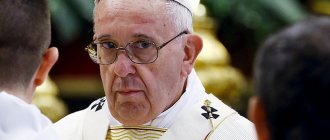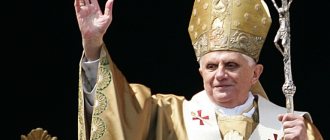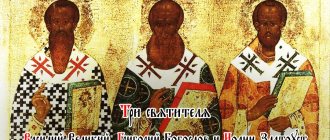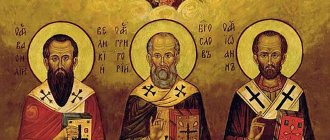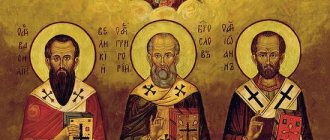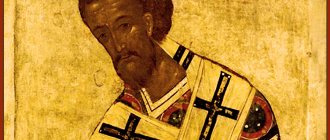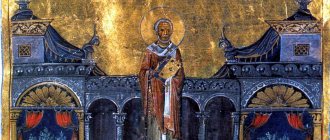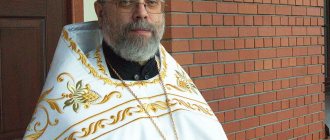Memorial Day: March 12(25)
Born around 540 into a noble and wealthy Roman family. Little is known about Gregory's activities before his accession to the papal throne. It is known that he was distinguished by great learning; for some time he was prefect of Rome, but in 574 he founded the monastery of St. Andrew in his possessions on the Caelian Hill in Rome and became a monk there.
In 579, the pope made him a deacon and sent him to Constantinople, where he asked to protect Rome from the Lombards, but Persian aggression prevented Byzantium from providing him military assistance.
In 585, Gregory returned to Rome, and in 590, after the death of Pelagius II during the plague, he became primate of the Church. It is believed that it was through his prayers that the epidemic stopped.
The name of Pope Gregory is associated with the rise of the Roman Church, which took over the reins of government from the secular administration, which was fading away under the blows of the barbarians. He personally led the defense of the city from the Lombards, and the leadership subordinate to Constantinople moved to Ravenna.
He tried to raise the authority of his department, which was pretty shaken at that time. The churches in the West clearly operated independently of Rome, especially in Carthage, Milan, and Aquileia. The relationship with the Patriarchate of Constantinople was also difficult. Of course, St. Gregory did not doubt the spiritual primacy of the Roman Church, but, nevertheless, not such a rigid church hierarchy headed by the Roman bishop as it later became. In contrast to the title “Ecumenical”, which began to be called the Patriarch of Constantinople, he called himself “a servant of the servants of God.” At the same time, Gregory considered it the duty of the Church to be a measure of piety and to criticize the actions of secular authorities when they do not act properly.
Constant state concerns interspersed with his labors to strengthen the declining Roman culture. His interpretations of the Holy Scriptures, numerous sermons and pastoral letters formed the backbone of the new Western theology, which would begin to develop later. He received the nickname “Dvoeslov” for one of his works “Dialogues”, dedicated to the lives of the saints of Italy.
St. Gregory composed in Latin the rite of the Liturgy of the Presanctified Gifts, which before him was known only in oral tradition. This order was approved at the VI Ecumenical Council in 680 and accepted by the entire Christian Church.
Constant wars, crop failures, and epidemics devastated the north of Italy; Gregory, exhausted by illness, dies in 604. His relics rest in the Cathedral of St. Apostle Peter in the Vatican. His veneration began quite early, and in the West the name “Great” stuck.
***
“Interlocutor” or “Double-talk”? Composition by St. Gregory the Great’s “Dialogues...” (translated as “Conversations...”, or “Interviews...”) – earned him the honorary title “Interlocutor.” The nickname “Dvoeslov”, which was assigned to it in the Slavic liturgical tradition, is associated with an erroneous translation of the Greek name of the ancient literary genre, which was included in Latin and other languages - διάλογος, dialogus, dialogue - “conversation”, conversation” (not necessarily two!), “exchange words." The Slavic translator, who was clearly dealing with the Greek text, confused the prefix διά-, dia- (in the meaning of through movement, reciprocity, that is, exchange of opinions) with the cardinal numeral δύο, duo- (lat. duo) - “two”, especially , that in late Greek the letter υ (“upsilon”) conveyed the sound “and”. It is significant that the compiler of the Slavic Menaion, who was more knowledgeable in Greek, translated correctly: “Interlocutor”!
Yuri Ruban, Ph.D. ist. Sciences, Ph.D. theology
Pontificate (590-604)
Gregory the Great Inspired by the Holy Spirit
, miniature from
Registrum Gregorii
,
c
. 983
After joining the papacy on September 3, 590, [1] Gregory was forced to face the heavy responsibilities that fell on every 6th-century bishop because, unable to count on effective Byzantine assistance, the economic income that the dominions reported from the Church did the pope was the only authority from whom the citizens of Rome could expect anything. It is unclear whether the Roman Senate still existed at this time, but in any case it did not interfere with the government, and Gregory's correspondence never mentions the great senatorial families who emigrated to Constantinople, disappeared, or disappeared. [2]
Only he had the necessary resources to provide the city with food and distribute alms to help the poor. To do this, he used the vast estates under the control of the Church, and also wrote to the praetor of Sicily with a request to send grain and church goods. [2]
He tried unsuccessfully to force the imperial authorities of Ravenna to repair the aqueducts of Rome, [2] destroyed by the Ostrogothic king Vitiges in 537.
[11] San Gregorio
, Juan de Nalda (
c
. 1500, Prado Museum, Madrid)
In 592, the city was attacked by the Lombard king Agilulf. The emperor's help was expected in vain; even the Greek soldiers in the garrison did not receive their pay. It was Gregory who had to negotiate with the Lombards, forcing them to lift the siege in exchange for an annual tribute of 500 pounds of gold (probably supplied by the Roman Church). He thus negotiated a truce and then an agreement to demarcate Roman Tuscia (part of the Roman duchy located north of the Tiber) and Tuscia proper (the future Tuscany), which would henceforth be Lombard. This agreement was ratified in 593 by the Exarch of Ravenna, the representative of the Byzantine Empire in Italy. [2]
One day, Gregory turned his attention to a group of captives who were in the public market in Rome to be sold as slaves. The prisoners were tall, handsome-faced and all fair-haired, which struck Gregorio most of all. Feeling pity and curiosity, he asked where they were from. “They are Anglos,” someone answered. « Non angli sed angeli
” (“They are not angels, but angels”), noted Gregorio, a phrase whose non-literal interpretation could be: “They are not slaves, they are souls.”
This episode prompted Gregory to send missionaries to the north, and this work was carried out by Bishop Augustine of Canterbury. When Augustine arrived in England, he wrote a letter to Gregory asking him what he should do about the pagan sanctuaries where human sacrifices took place. Gregory's response (preserved in the Book of Bede) was: "Do not destroy sanctuaries, cleanse them", referring to the fact that pagan sanctuaries had to be rededicated to God.
Gregory formed alliances with the monastic orders and the kings of the Franks in opposition to the Lombard duchies, taking a position of secular power separate from the Empire. [ 12 ]
He also organized the administrative and liturgical tasks of the church. [ 13 ]
Gregorio died on March 12, 604; his epitaph called him Consul of God
. [3] He was proclaimed Doctor of the Church by Boniface VIII on September 20, 1295, although the title had already appeared around the year 800. He is one of the four great fathers of the Western Church, along with Jerónimo de Estridón, Agustín de Gipona and Ambrosio de Milan. [ 14 ]
external reference
- Wikiquote collects famous quotes
by or about Gregory the Great - Wikimedia Commons has a multimedia category dedicated to Gregory the Great
. - Wikimedia Commons has a multimedia gallery dedicated to Gregory the Great
.
- Benedict XVI introduces Pope Gregory the Great
- Benedict XVI: Saint Gregory, Pope Great, "servant of the servants of God."
- Saint Gregory the Great: Christ the Good Shepherd
- Texts by Gregorio Magno (some in French, others in bilingual Latin - French) on the website of Philippe Remacle (1944 - 2011).
| Control of authorities |
|
- Data: Q42827
- Multimedia: Gregory the Great
- Famous Quotes: Gregory I the Great
References
- ↑ A b
"Gregory I the Great".
www.vatican.va
. Retrieved September 13, 2022. - ↑ a b c d e f h i j Dutour
, Thierry (2003):
Medieval city.
The Origins and Triumph of Urban Europe. —Paidos, Buenos Aires, 2005, pp. 42 and 45–47. ISBN 950-12-5043-1 - ^ AB Brown
, Peter (2012).
The World of Late Antiquity
. Madrid: From the editor. paragraph 130. ISBN 978-84-249-2341-9. - Benedict XVI (2008). "Saint Gregory the Great". MAIN AUDIENCE.
Wednesday, May 28, 2008 (Libreria Editrice Vaticana). - ^ A. B. Brown
, Peter (1996):
The First Millennium of Western Christendom.
- Critique, Barcelona, 1997, pp. 124-125. ISBN 84-7423-828-5 - ↑ a b Rome (Collection of visual guides)
. 192 pages. Madrid: El Pais-Aguilar. 2011. ISBN 978-84-03-50995-5. - MASOLIVER, Alejandro Maria (1994). History of Christian Monasticism. Meeting. ISBN 978-84-7490-327-0.
- Cameron, Averil (1993): The Mediterranean World in Late Antiquity, 395-600.
- Critique, Barcelona, 1998, p. 135. ISBN 84-7423-760-2. - Jump up ↑ A b
Leonardi, C. (2000).
"Gregory I the Great". In Leonardi, S.; Riccardi, A.; Zarri, G., ed. Dictionary of Saints I.
Madrid: San Pablo. pp. 958-963. ISBN 978-84-285-2258-8. - Cm . Pablo Diacono, Historia Langobardorum
3, 20. (text in Latin and English) - Dutour, Thierry (2003), pp. 43-44.
- Orlandis, Jose (1999). History of the Church. Ancient and medieval church. Word editions. ISBN 9788482392561.
- "Carmen Castillo, San Gregorio I Magno, Great Rialp Encyclopedia".
- Danielu, Jean; Marroux, Henri-Irene (1982). New history of the church. From the Origins to Saint Gregory the Great. Christian publications. ISBN 9788470570384. The help uses the obsolete parameter |coautores=( help )
- Jump up ↑ San Gregorio Magno (1989). Zaragoza Pascual, Ernesto, ed. Saint Benedict of Nursia
. Lumen. ISBN 950550019X. - Henn, Philip (2011). Gregory the Great. Madrid: Word Editions. paragraph 119. ISBN 978-84-9840-510-1.
- Brown, Peter (1996), p. 130.
- "Eltestigofiel.org, Saint Gregory I the Great, Pope and Doctor of the Church." . Archived from the original on September 10, 2015. Retrieved September 5, 2015.
- "Ewtn.com in Spanish, Saint Gregory I the Great, Pope and Doctor of the Church." .
